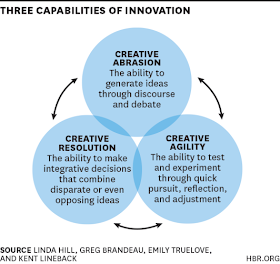“Why
aren’t our engineers more innovative?”
Have you ever heard senior management make that complaint? I have at many companies around the world and from executives in many different industries. Well, to answer that question I would like to contrast the typical innovator with the typical design engineer.
Have you ever heard senior management make that complaint? I have at many companies around the world and from executives in many different industries. Well, to answer that question I would like to contrast the typical innovator with the typical design engineer.
I
have worked with dozens, even hundreds, of both types. And although these tables are a composite
caricature, I think they are pretty accurate.
The innovator is a possibility generator whereas the engineer is a problem solver. Let’s say your business is facing a problem that needs to be solved quickly for you to continue to grow. If you picture a funnel, the innovator sees the funnel constantly expanding to more and more ideas. They are thinking of multiple options for addressing the problem. While the engineer is holding the funnel the other way and narrowing down possible options to a single viable solution.
The innovator is a possibility generator whereas the engineer is a problem solver. Let’s say your business is facing a problem that needs to be solved quickly for you to continue to grow. If you picture a funnel, the innovator sees the funnel constantly expanding to more and more ideas. They are thinking of multiple options for addressing the problem. While the engineer is holding the funnel the other way and narrowing down possible options to a single viable solution.
The
innovator is often connecting diverse systems and concepts to create totally
new connections with new applications.
The engineer is isolating systems and attributes to resolve a problem or
optimize performance.
Innovators
often love challenging the status quo.
They try unconventional approaches.
Some work, many don’t, but each leads to another idea. The engineer has been trained to use the
discipline of following the best practice procedure or professional standard to
minimize failures and ensure the result is compliant.
The
innovator brainstorms an idea and runs some tests to see what might happen. The innovator is trying to expand their knowledge
of how products and systems could perform. The engineer analyses a problem, develops a
solution, and runs some tests to prove that the solution works as expected. The engineer is demonstrating that they already
have the knowledge to understand how the products and systems will perform.
The
innovator’s ideas often require transformational change to a company or
industry – and culture change is always long and dangerous. The engineer’s ideas are often incremental changes
to improve performance of an attribute of a well-established product or
process. This improved performance is
welcomed by both the customer and the company management.
An
interesting element of personal characteristics is that both successful
innovators and engineers are technical experts and display the character quality
of perseverance.
So
if the character qualities are the same, why aren’t more engineers
innovative? Let's look at the other
characteristics. Does your organization
reward and recognize people who have lots of ideas that upset the status quo,
raise more questions than they answer, and often result in test failures? Or does your organization reward and
recognize people who generate a solution to problems that works well the first
time with the current systems?
In
addition to the management systems, our universities teach
and train engineering, not innovation. I
am not aware of a school that offers a technical degree in innovation. They may have an MBA for entrepreneurs, but
that focuses on risk management, venture capital markets, and recruiting a
team. It is not focused on technical
innovation.
So what is the answer? If engineers are problem solvers, then
reframe the problem so that the answer requires innovative solutions instead of
incremental solutions. Today when a
company initiates a new product development project it often starts with the
engineers turning to marketing and asking, “What is the problem?” “What does the customer want the product to
do that it does not do today?” This
leads to minor enhancements on existing products, not innovative new product
categories. The engineers demand a set
of fixed requirements to start the project.
Instead, the engineers should work with customers
and customer experience data to determine what the customer would “like” to do,
which is often not what the customer is actually doing. For engineers to become innovators, they need
to start with the assumption that the product as it exists today is a
generation behind in the required technology and then rethink how best to
provide the customer with a product or system that lets them accomplish their
goal. This will change how they use
their technical problem solving skills.
They won’t be trying to fix the product; they will be trying to fix the
customer experience.
That will lead to innovation.
That will lead to innovation.








